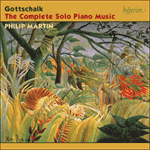One of Gottschalk’s works published posthumously (this in 1879),
Hercule is way beyond the realm of the amateur and requires, indeed, a Herculean pianist to play it at all. It is a prodigiously difficult work though the structure of the piece is simple enough: a jaunty little march tune (which will not leave your head for days) is subjected to different and increasingly difficult pianistic figures. The initial idea is stated over eight bars; thereafter it is extended to sixteen bars incorporating a wonderful ‘wrong-foot’ modulation from the tonic (B major) to D major and back again in time for the next variation, of which there are six in all. The third of these relies on triplets in thirds played by alternate hands, the fourth on huge crossed-hands chords, the sixth using the same device in triplets with alternate thumbs highlighting the melody.
from notes by Jeremy Nicholas © 1997
Hercule, l’une des œuvres de Gottschalk publiées posthumément (en l’occurrence, en 1879), dépasse de beaucoup le domaine de l’amateur, requérant même un pianiste herculéen. Il s’agit d’une œuvre prodigieusement difficile, en dépit d’une structure, assez simple, de petite marche allègre (qui ne vous quittera pas pendant des jours) soumise à diverses figures pianistiques de difficulté croissante. Le thème initial est énoncé sur huit mesures, avant d’être étendu à seize, avec une merveilleuse modulation «à contre-pied» de la tonique (si majeur) au ré majeur, avec un retour à temps pour la variation suivante. Des six variations de l’œuvre, la troisième repose sur des triolets en tierces, joués par les mains alternées, et la quatrième se fonde sur d’énormes accords exécutés les mains croisées, tandis que la sixième reprend le procédé en triolets, les pouces venant en alternance rehausser la mélodie.
extrait des notes rédigées par Jeremy Nicholas © 1997
Français: Hypérion
Hercule, eines von Gottschalks postum veröffentlichten Werken (1879), gehört keineswegs mehr zum für den Amateur spielbaren Repertoire, und für die Interpretation dieses Stückes bedarf es wahrlich eines „herkulischen“ Pianisten. Trotz seiner recht einfachen Struktur ist das Werk erstaunlich schwer: Ein fröhlicher kleiner Marsch (eine Melodie, die Ihnen nicht mehr aus dem Kopf gehen wird) wird von verschiedenen und zunehmend schwierigeren pianistischen Figuren herausgefordert. Die Grundidee wird innerhalb von acht Takten dargelegt und nachfolgend auf sechzehn Takte erweitert, in deren Verlauf sich eine wundervolle, „umgedrehte“ Modulation von der Tonika (H-Dur) nach D-Dur und wieder zurück vollzieht, gerade rechtzeitig für die nächste Variation. Es sind insgesamt sechs Variationen zu hören, von denen die dritte durch Terz-Triolen bestimmt wird, die abwechselnd in beiden Händen gespielt werden. Die vierte und sechste Variation spielen mit enorm großen, übergreifenden Akkorden beziehungsweise Triolen, wobei in der sechsten von beiden Daumen im Wechsel melodische Akzente gesetzt werden.
aus dem Begleittext von Jeremy Nicholas © 1997
Deutsch: Manuela Hübner


 Gottschalk: The Complete Solo Piano Music
Gottschalk: The Complete Solo Piano Music
